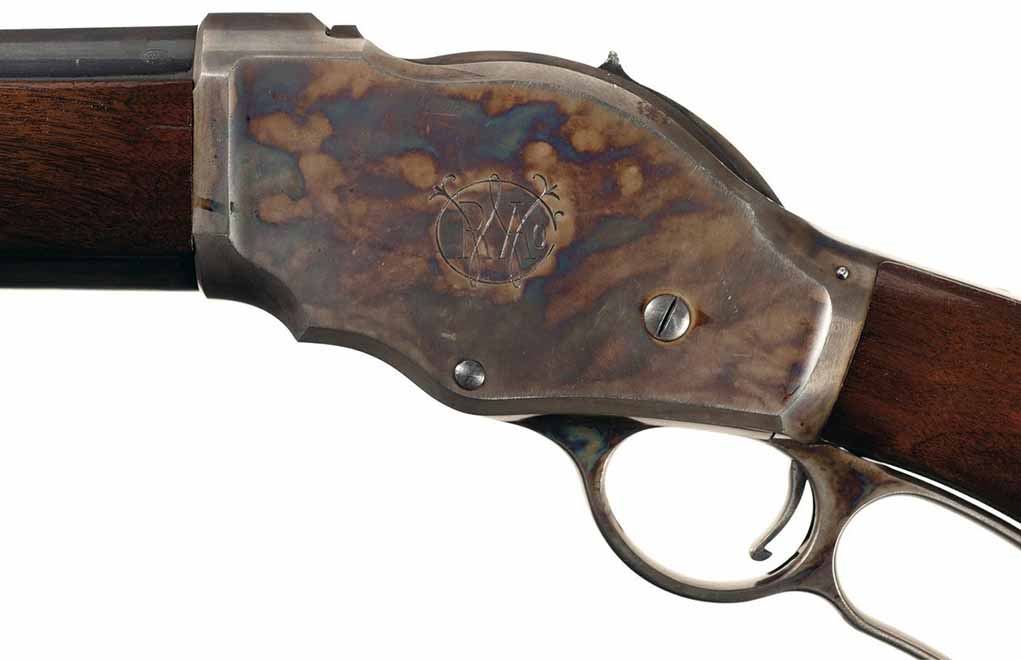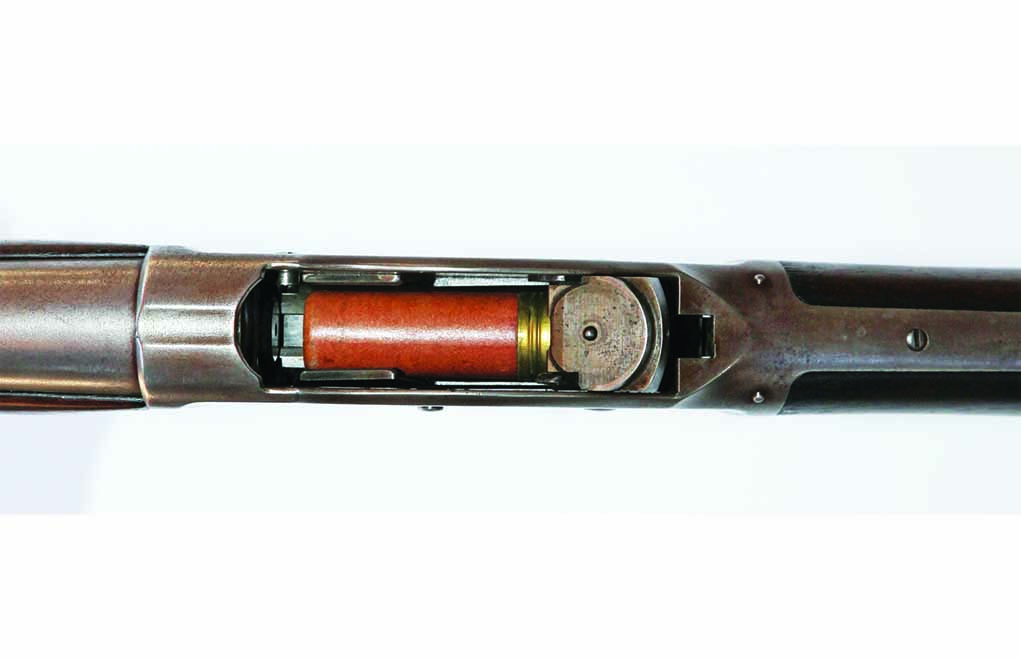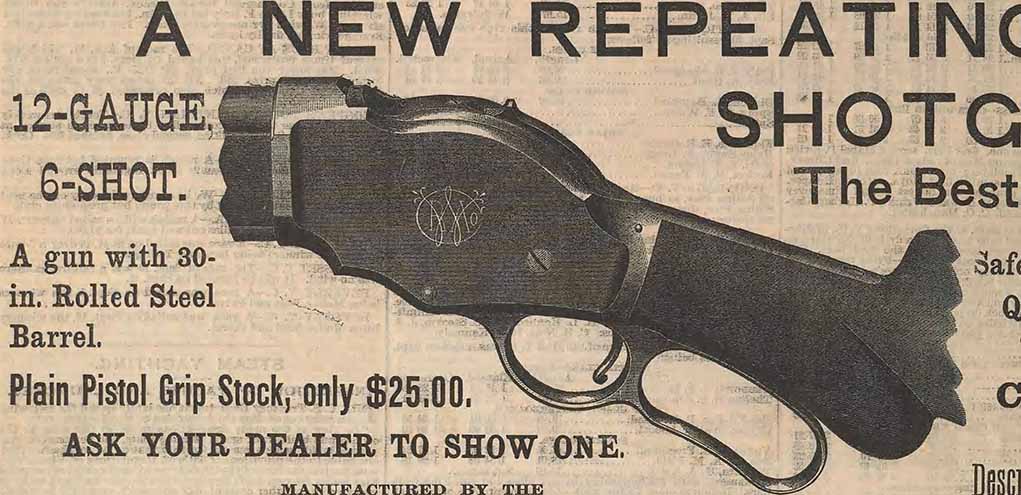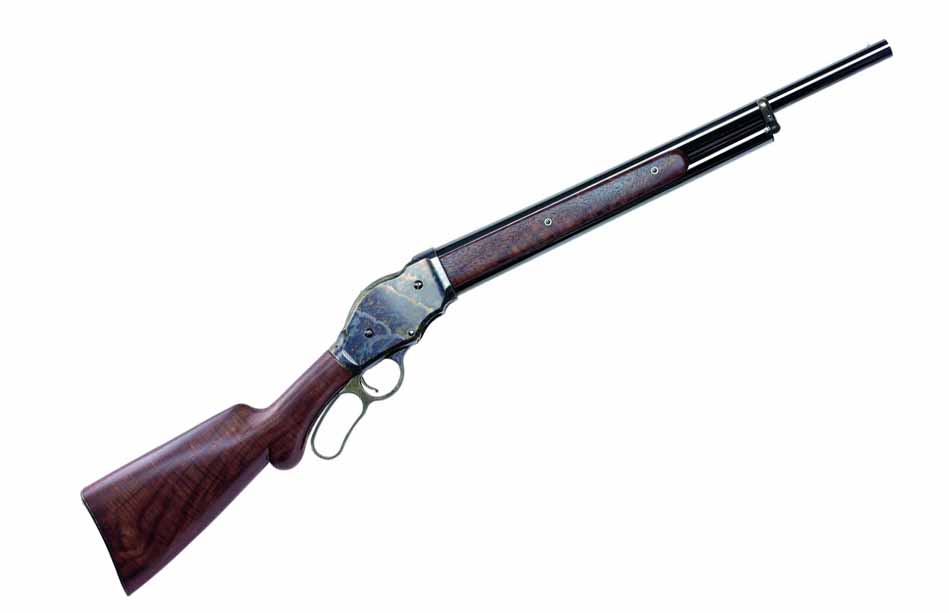

From innovative black-powder repeater to modern throwback arm and dandy field gun, the All-American lever-action shotgun continues to soldier on.
What You Need To Know About The Lever-Action Shotgun:
- The first commercially successful repeating shotgun (Winchester 1887) was a lever-action.
- While the style of shotgun disappeared for decades, it reemerged with the rise of Cowboy Action Shooting.
- It makes an excellent option for game such as turkey, due to its ability to cycle quickly while holding on the target.
From the start, John M. Browning didn’t think it was a good idea. After all, a lever-action shotgun would be unwieldy, comparably slow and God awful on the knuckles. Try as he might, the legendary gun designer couldn’t veer Winchester Repeating Arms to a pump-action design. Management wouldn’t budge. Dagnabit, they were a lever-gun company, anything less was an affront.
So was born the first successful repeating shotgun—the Winchester Model 1887, later to become the 1901 with the advent of smokeless powder.
Certainly, Browning had it right, pump-action and later semiautomatic shotguns were the wave of the future for fast shooting, easy-to-operate smoothbores. For most applications, everything about them enhanced the efficient use of the generally hard kicking class of gun.
But it’s tough to argue the gun genius’s capitulation to the gun manufacturer’s whims has made for one of the most unique, timeless and downright nasty classes of shotguns. The lever-action shotgun will never top the heap, but there is no doubt it isn’t going anywhere soon.
Genesis Of The Lever-Action Shotgun
To modern eyes, the Winchester 1887 has a lumbering appearance. Dromedary-shaped action, short and thick buttstock and the typically long barrel of a black powder shotgun, it’s not exactly the first iron you’d grab come grouse season. Yet, at the time—in an age that would have viewed the lever-action shotgun as equally as awkward—it had a great advantage.

Whether you realized it or not, the shotgun was perhaps the most used—if not deadly—firearm of the Old West. James “Kill’n Jim” Miller was blistering hell with one in his hands (a skill that eventually led him to a dance at the end of a rope). But more so, it was the perfect tool for Manifest Destiny. Aside from good and bad men, every pioneer, farmer, rancher and likely last remaining mountain men had a smoothbore at beck and call. As pragmatic as those times, you could as easily fend off a grizzly bear or a claim jumper, as you could knock a duck off the wing with one. If you could do it in two shots.
Therein lies the edge of the 1887—it wasn’t a side-by-side. Before the Winchester lever-action shotgun hit the scene, that’s all that was on hand. Aside from their limited capacity and glacial reload time (no ejectors), these side-by-sides were hammer guns that had to be manually cocked to get into action.
On the other hand, the Model 1887 held 5+1 shells and, comparably, shot at a respectable clip. Sure, it wasn’t optimized for an accelerated firing rate or as intuitive as other potential designs, but it sure beat the alternative. Succinctly put, in the land of the blind, the one-eyed man was king.
Certainly, the 1887 had its drawbacks. As anyone who’s had the pleasure of being at the business end of one of the 12- or 10-gauges knows, it’s not the easiest firearm to load. Given there’s no loading gate and the action opens from the top, you have to reach through the receiver to insert a shell into the tubular magazine. And the lever-action shotgun and its progeny weren’t exactly nimble. Initially, the 1887 came with a 30-inch barrel standard—a 20-inch variation offered much later. And the 1901 came outfitted with a behemoth 32-inch barrel. Hyperbolically speaking, that’s teetering on punt gun territory.

Despite these drawback, the Winchester 1887 is as elegant as any of the other guns scratched together by Browning. Utilizing a rolling block action, the lever-action shotgun was not only rock-solid, but also extraordinary simple. Early on, Winchester touted the latter aspect, boasting the action only had 16 parts.
Further, Browning made the 1887 as easy to operate as the design would allow. Primarily, this was achieved by dedicating the opening stroke to the lighter duty of extracting the spent shell and the closing stroke the more heavy work of compressing the hammer spring. You’d rather do the latter with your palm than your knuckles. Plus the trigger lays back on the trigger guard until the lever is almost closed, so you avoid the unpleasant experience of stabbing yourself with it.
These and other aspects made a good system, but not an enduring one. Less than a decade after its introduction, the 1887’s sales petered out. Though, it had one last gasp of life as the more stoutly built smokeless powder 10-gauge—the Model 1901. Another Browning design supplanted the lever-action shotgun, the iconic Winchester Model 1897—to a lesser extent its forerunner the 1893. Pump-actions both, it seemed Browning had it right from the start.
Rebirth Of The Lever-Action Shotgun
Funny thing about the closing of the American West, it didn’t quite shut the lid on the lever-action shotgun.

Sure enough, the design disappeared for decades, smoothbore fanatics had other things to keep them busy—pump-actions, semi-automatics and over/unders. Then, like a prairie twister, the lever-action touched down again. Winchester dabbled with the .410 Winchester 9410 in the 1990s, nearly a decade later Marlin introduced a lever .410 of their own, Henry Repeating Arms followed suit a little over 10 years later.
Nifty (and useful, we’ll get to that in a moment) as those small-bores proved, it wasn’t really what breathed new life into the lever-action shotgun. Wistfulness for the old west did … that and a cyborg from the future.
Raise Your Lever-Action IQ:
- 5 Of The Best Lever-Action Rifle Options Available Today
- 7 Best Lever-Action Rifles To Ever Sling Lead
- 5 Must-Have Henry Lever-Action Rifles
- 7 Marlin Lever-Action Rifles Worth Adding To Your Collection
- .357 Magnum Lever-Action: The Best Pistol Caliber Carbine?
- 9 Greatest Winchester Lever-Action Rifles, Shotguns and Bolt-Actions
Cowboy Action Shooting—basically 3-Gun with period-correct firearms (replica and original) and duds—saw an incredible surge in the last quarter of the 20th Century. Those who couldn’t root out or afford a vintage Model 1887 and wanted to shoot the lever-action in a match created a market.
So did the 1991 film Terminator II. Spin cocking a sawed-off riff on an 1887 on the back of a Harley-Davidson, Arnold Schwarzenegger brought more attention to the level-action shotgun than it had had since Grover Cleveland was in the White House. Go figure.
by in large, the rebirth of the 1887 has had a foreign accent—Chinese and Italian. The Chinese Norinco was an early purveyor of the design, particularly a model fashioned after the Terminator’s gun, and won mixed review. Today there’s a non-descript “Chinese Made” 1887 is available at Century Arms for the princely sum of $380. A get-what-you-pay-for affair.
Italian gunmaker Chiappa, on the other hand, has earned more accolades, producing a more finely made option. In addition to selling under their name, they’re also imported by several replica specialists, manufactured to those company’s specifications.
Given Browning never worked in polymer, there are several variations of the lever-action shotgun that are a drastic break from the original design. So what?
Almost every replica 1887 is in one major way—they’re capable of shooting shells loaded with smokeless powder. But they aren’t technically 1901 knockoffs—for marketing purposes, mainly—but also since nearly every dang one of them is a 12-gauge.
A Modern Place Of The Lever-Action Shotgun
There are plenty of makes/models that owe their present existence to the field of competition. Yet, the lever-action shotgun has more depth to it than throwback shooting matches. Despite flying in the face of convention, it still has a role as a field gun and as a defensive arm.

Outside the 1887, the lever-action shotgun is primarily a .410 affair now, which might sound a little light by modern standards. Certainly, no one will argue against a small-bore scattergun for first-timers and youths, looking to master arm before having to deal with recoil. More so, with ammunition advancements, the .410 has found a new lease on life in turkey season. Improvements in wad design and heavier than lead shot, hunters have gravitated to the smaller—arguably faster shooting—diminutive bore.
Combine with a lever-action, the .410 becomes a formidable tool for knocking down a strutting gobbler—perhaps a better one than a pump. How so? You can shoot it more like a rifle. Take a kneeling or cross-legged position, for example. You can build a solid base with your support elbow on your knee to aim and never have to break it down to apply a follow-up shot. The same cannot be said of the pump-action.

Henry’s 19.5-inch barreled lever-action .410 and Marlin’s 22-inch barrel 1895 .410 both fill this role extremely well, even if—in both cases—you have to drill and tap them if you hunt with a scope. Henry perhaps has the edge, given its shotgun uses Invector removable chokes—Marlin has choke options, but all are fixed. Either way, someone searching for a fast, accurate and light-recoiling turkey gun couldn’t do much better.
On the home front, the lever-action is also viable, particularly with the meteoric rise of the bird-head grip. Given these firearms are generally shot at the hip, the lever-action proves as efficient as the pump to cycle the shotgun. More so, for certain individuals more comfortable with the former over the latter. Black Aces Tactical certainly sees it this way.

Long demanded, the Florida company came out with a convertible lever-action smoothbore line—Pro Series L— which comes with both a shoulder stock and bird’s head grip. The 12-gauge—capable of chambering 3-inch shells—is considerably larger than many grip-option firearms, boasting an 18.5-inch barrel. Still, outfitted with the grip it should prove plenty nimble and no less quick and potent.
Parting Shot
Despite its long history and somewhat recent resurgence, the lever-action shotgun isn’t going to become America’s preferred smoothbore anytime soon. That’s alright. It perfectly fills its present niche. As time goes on, clever gun designers will most definitely find new roles for the shotgun to play. Who knows what the future might hold for the All-American design? Whatever it is, one thing is certain—the lever-action shotgun will continue to endure.
Shotgun Insights: Everything You Need to Know
- Best AR-12 – Top Picks for Tactical Shotguns
- 410 Shotgun Buyers Guide – Everything You Need to Know
- Best Over/Under Shotguns – Affordable Doubles
- Best Semi Auto Shotguns – Scatterguns For The Field And Defense
- Buyer's Guide: Best Budget Double Barrel Shotguns
- 8 Gauge Shotgun – A Closer Look at This Forgotten Classic
- Tactical Shotgun Buyers Guide – Everything You Need to Know
- Best Pump Action Shotguns – A Buyer's Guide
- Top Bullpup Shotguns for Defense

Next Step: Get your FREE Printable Target Pack
Enhance your shooting precision with our 62 MOA Targets, perfect for rifles and handguns. Crafted in collaboration with Storm Tactical for accuracy and versatility.
Subscribe to the Gun Digest email newsletter and get your downloadable target pack sent straight to your inbox. Stay updated with the latest firearms info in the industry.

![Best Concealed Carry Guns In 2025 [Field Tested] Wilson Combat EDC X9S 1](https://gundigest.com/wp-content/uploads/Wilson-Combat-EDC-X9S-1-324x160.jpg)


![Best 9mm Carbine: Affordable PCCs [Tested] Ruger Carbine Shooting](https://gundigest.com/wp-content/uploads/Ruger-Carbine-Shooting-100x70.jpg)
![Best AR-15: Top Options Available Today [Field Tested] Harrington and Richardson PSA XM177E2 feature](https://gundigest.com/wp-content/uploads/Harrington-and-Richardson-PSA-XM177E2-feature-100x70.jpg)
